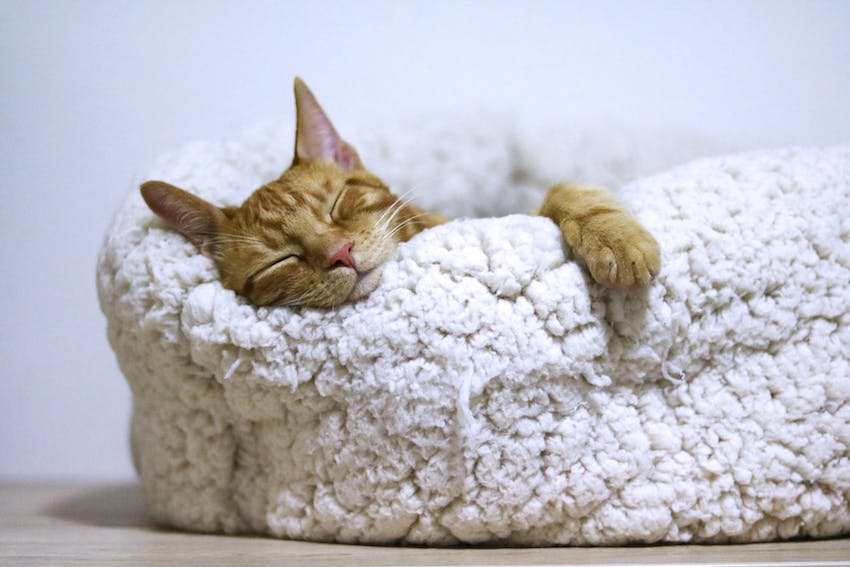Ready to help treat your pet to a healthy life?
Do Pets Dream While Sleeping
By : Kathleen Crampton | Published Jul 31, 2025

You’re enjoying a quiet moment on a lazy Sunday afternoon. Your dog and cat are snoozing nearby and you’re watching your favorite show. Suddenly, you notice some movement. Your pets’ paws are twitching and their eyelids are moving rapidly. The furry little pals are even making tiny yelping and mewing sounds. Pet parents everywhere know these cute scenarios well, as they watch their four-legged loved ones seemingly caught up in playful sleep. But it leads many to wonder: Do pets dream?
We know that humans dream, but what about dogs and cats? Unfortunately, pets can’t keep dream journals or tell us about the wild escapades they had during naptime, so we have to rely on veterinarians and canine and feline researchers to share their insights.
Let’s walk through, first, the science of sleep in animals (humans included), then dive into what researchers know about cat and dog dreams. You’re one step closer to understanding your furry companion.
The science of sleep in animals
Sleep, or at least resting periods, is universal among many species. While some animals, like koalas, sleep for about 20 hours a day, others, like whales and dolphins, sleep with only half of their brain “turned off.” The other hemisphere remains active and alert to any dangers.
But do all animals that sleep also dream?
Scientists have identified key markers of dream states: non-rapid eye movement (NREM) sleep and rapid eye movement (REM) sleep. While humans have been shown to dream in both states, REM is the more active sleep state. In this state, individuals tend to have more vivid dreams, displaying not only jerky physical movements but also heightened cortisol that resembles the cortisol levels during waking hours. Studies confirm these sleep cycles through what’s called electroencephalography (EEG) recordings, which monitor brain activity. But it’s not just the science that confirms that humans dream — we often remember our dreams when we wake up.
Unfortunately, animals can’t tell us whether they relived moments of the day during their sleep, but that doesn’t mean that researchers can’t make reasonable assumptions based on data. EEG recordings have also been applied to animals while they sleep, including dogs.
Do dogs have dreams?
You likely spend most of your waking hours with your pet, playing with them, training them, and, of course, cuddling with them. They become your right-hand pal with whom you share your deepest thoughts. It makes sense that you want to know more about them, too, including if they dream.
Here’s what scientists do know about dogs’ sleep:
- Dogs also experience two sleep states, NREM and REM, and approximately 12% of their sleep involves the REM cycle.
- Their REM states show similar signs as human REM states, with rapid, shallow breathing, twitches, and rapid eye movements.
- Dogs sleep for about 10 hours a day on average, while puppies sleep more.
- EEGs confirm that dogs experience REM episodes for about 6 minutes of an approximate 20-minute-long sleeping period.
Dogs’ sleeping patterns seem to closely resemble that of humans — albeit for shorter periods of time (for example, humans can experience REM episodes of up to 60 minutes). But this isn’t the only reason to assume that dogs also dream. Another is that dogs, like humans, also show that they’re consolidating memory during sleep.
Memory consolidation is something that happens during humans’ REM cycles, allowing us to sort through emotions, scenarios, and concepts and leading to enhanced memory performance. This outcome has been shown to occur during dogs’ sleep, too. In one study where brain scans were taken of sleeping dogs, the ability of dogs to learn and retain certain commands correlated with their level of brain activity shown in EEG recordings.
But memory consolidation can also play a role in the content of dreams, as shown in studies of rats. In one study on dreams in animals, scientists discovered that rats dreamt about the tasks they completed during waking hours, and in another study, researchers were able to identify that rats were reliving an earlier moment while asleep.
So, what does all of this mean for dogs’ dream states? There’s still not enough research to show what dogs really dream about, but because their sleep states share similarities with humans and other animals, it’s safe to assume that they do dream.

Do cats dream, too?
What about our feline friends? It’s no secret that cats are the snoozing types, curled up somewhere cozy for much of the day. In fact, cats sleep for 18 to 20 hours per day, on average. So, what portion of that, if any, is spent dreaming?
In the 1960s, researchers of feline sleep discovered that cats do, just like dogs, experience NREM and REM cycles. Then, in the late 1970s, it was determined that cats likely have a rich dreamlife based on their motor activity displayed while sleeping.
As with dogs, research on whether cats dream or not isn’t conclusive. After all, our pets can’t relay the content of their sleep states. But even though cats sleep a ton, they still experience similar sleep cycles as humans and seem to relive certain aspects of the day while sleeping. That knowledge, paired with what scientists know about sleep in animals (like the evidence shown in the rat studies we mentioned earlier), can lead to a similar assumption as dogs — that cats likely have dreams.
Signs your pet is dreaming
While the answer to “do pets dream while sleeping” isn’t 100% conclusive, there are some telltale signs that your pet might be dreaming. These signs are associated with the REM part of their sleep cycle:
- Irregular breathing, like fast, short breaths
- Rapid eye movements
- Twitching
- Fluttering eye lids
- Making movements like they’re running
- Soft yelps, barks, whines, meows, or purrs
If you notice these signs, it’s best to let your dog or cat keep sleeping. Experts caution against waking a pet that is in deep sleep because they might become startled and even react aggressively when woken up. According to one analysis of nearly 500 people in the UK who had been bitten by a dog, approximately 6% of incidents occurred after the dog had been sleeping.
Think of it like this: If someone wakes you up while you’re in a dream, it can be very disconcerting! The same goes for your pet.

How to support your pet (beyond their wildest dreams)
It’s important to not only give your pet proper training and exercise but also provide them with a comfortable space to sleep. Dogs and cats, and even different breeds and ages, have varying sleep needs. While we may not be 100% sure of the answer to “do pets dream?” it’s still crucial to support safe and restful sleep for your furry companion.
And don’t forget to further protect your pet with a pet insurance policy, which can help to cover the costs of unexpected treatments. So, perhaps while your pal is getting a snooze in, learn more about the benefits of pet insurance and how to protect them at all hours of the day.
